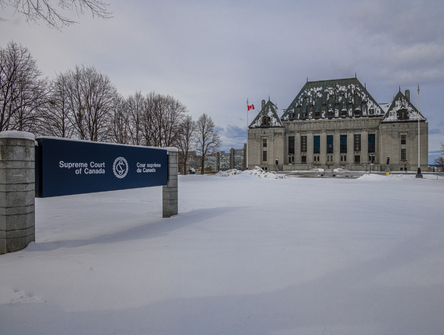Supreme Court strikes down Ontario's limits on third-party advertising
The Ford government had invoked the notwithstanding clause to protect changes to the Electoral Finances Act (EFA) from a court challenge

In a 5-4 decision, the Supreme Court of Canada struck down Ontario Premier Doug Ford’s limits on third-party political advertising in the year before a provincial election.
The province invoked the notwithstanding clause to protect changes to the Electoral Finances Act (EFA) from a court challenge. However, the Working Families Coalition and others brought one under Section 3 of the Charter of Rights and Freedoms, which protects the right to vote and is not limited by the clause.
The Ford government’s changes to the legislation meant third parties were subjected to spending limits of $24,000 in any one riding and up to $600,000 total for political advertising in the twelve months before an election period. Political parties, on the other hand, can spend up to $1 million in the six months before an election period.
For the majority, Justice Andromache Karakatsanis wrote that the Court had already established that meaningful participation in the electoral process requires citizens to be able to vote in an informed way. While spending limits may level the playing field to ensure wealth can’t be mobilized to drown out other voices, limits that restrict rather than promote access to diverse information may violate citizens’ rights to meaningfully participate.
“Third parties are strictly limited in their ability to inform citizens while political parties face no restrictions for the first six months of the pre-writ year,” Karakatsanis said, including the emphasis.
“This differential treatment creates a disproportionality in the political discourse. Further, this disproportionality in political discourse persists over the second six months: if third parties do provide their perspectives in the first six months of the pre-writ year, they may be unable to contribute meaningful information closer to the election.”
In dismissing the appeal, Section 37.10.1(2) of the EFA has been struck down. Because the violation was under Section 3, the court decision is not curtailed by the province’s use of the notwithstanding clause.
The Canadian Civil Liberties Association intervened in the case and called the decision a huge victory for democratic rights.
“It was very important for the Court to find that [Ontario] created by design absolute disproportionality,” says Anaïs Bussières McNicholl, director of the CCLA’s fundamental freedoms program.
“As well, under the Section 1 analysis, we see that they echoed our submissions because they found that courts should examine legislative choices more closely where rights at the heart of democracy are at stake.”
The broad and purposive approach to Section 3 allowed it to be successful even though the notwithstanding clause had been invoked. Bussières McNicholl says it’s helpful guidance for the future, as there are other challenges in other provinces, including Quebec, where there is a challenge of the “freeze” of the electoral map.
Vibert Jack, litigation director for the BC Civil Liberties Association, also intervened in the case and was pleased that the majority used an interpretive approach as his group had suggested.
“They didn’t just look at the unions and civil society organizations that were bringing the challenge, they took a look at the bigger picture and compared them to political parties and made sure that the egalitarian approach to elections was maintained,” he says.
“I think that will avoid things going too far in either direction in the future. We really don’t want any actor, whether it’s an individual, a political party, or a private interest group, to have a disproportionate voice in the political process.”
The judgment contained two sets of dissenting reasons. Both agreed that the spending limits did not infringe on Section 3 rights but with slightly different reasons. Chief Justice Richard Wagner and Justice Mary Moreau wrote that Section 3 contains both expressive and informational components, while Justices Côté and Rowe felt there was no expressive component.
Emmett Macfarlane, a political science professor at the University of Waterloo, says that while he appreciates that the Court struck down Ford’s “dirty tricks,” he nevertheless found the dissenting reasons of Côté and Rowe the most persuasive.
“I think they are correct that the other judges are basically importing Section 2(b) on free expression into Section 3 on voting rights,” he says.
“The majority has taken a very expansive understanding of the principle of meaningful participation that the Court has previously found to be a part of Section 3 and given a fairly robust expressive component. I think Côté and Rowe are right to point out that the jurisprudence doesn’t really say that.”
Macfarlane says most meaningful participation cases haven’t come in the context of third-party spending but in other electoral rules cases, such as how many candidates need to be put forward to get certain funding thresholds or who is eligible to vote in a Quebec referendum based on residency requirements.
Jack says there is an overlap between Section 2(b) and Section 3 rights, and that voters have a right to be informed and to make informed decisions.
“Realistically, the right to be informed isn’t very meaningful if there also isn’t a right to provide information,” he says.
“From our perspective, Section 3 has to protect the right to political expression to some degree in order for the right to be informed as a voter to be vindicated.”
Macfarlane adds that he doesn’t find the majority did a very good job of distinguishing why the Ontario provisions failed compared to the federal law at issue in Harper in 2004.
“They don’t really spend a lot of time on that,” he says.
“They emphasize pre-writ versus campaign period, but the campaign period is in some ways even more important because that’s when people really start paying attention to politics. I have a hard time reconciling the majority’s decision with the Court upholding the limits in Harper. It seems like a pretty messy framework for assessing these things.”
Macfarlane notes that in siding with the province, the trial judge weighed the evidence and concluded that the third parties could still have their voices heard, but that was not part of the majority’s decision.
“Either the spending limit imposed is justified or it’s not, almost independent of what the parties are doing unless the idea of being drowned out is identifiable, and I’m not sure how you’d do that,” he says.
“Media coverage is going to gravitate toward party leaders at the expense of everyone else, so how do you weigh that? Normally, the Court would be a little more deferential to the empirical findings at the trial level.”


